World War 2 Memorial is the landmark honoring Americans who fought for their lives in world war 2 as civilians and in the armed services.
From the moment it was established in the spring of 2004, the World War 2 Memorial was indeed a hit with attendees.
Hundreds of World War 2 veterans gathered at the state capitol on Memorial Day weekend that year to see the memorial’s ceremonial dedication.
It is on the National Mall in Washington, D.C. It comprises 56 pillars signifying the territories and states of the United States and a couple of miniature edifices symbolizing the theaters of the Pacific and Atlantic regions.
The memorial, planned by Friedrich St. Florian, a former executive of the Rhode Island School of Design, depicts the significant correlation between the home front and the combat front.
Americans at residence and those battling abroad depended on each other’s assistance during this pivotal event in the twentieth century.
On the 29th of May, 2004, U.S President George W. Bush inaugurated the memorial. The memorial, however was launched on the 29th of April, 2004.
The memorial is managed by the services of the National Park as part of its programmes dedicated to the Memorial park and National Mall.
The memorial has always gained fame since its inauguration and by 2018 around 4 million visitors have visited it.
Does the World War 2 memorial include veteran names?
Content
No, it does not. Unlike the Vietnam Veteran’s Memorial, no names are included at the World War 2 Memorial. Instead, veterans killed in action are honored with gold stars.
Architecture

The memorial comprises 56 17-foot-tall granite columns set in a shape of a semicircle which is around a patio with 2 tall about towers with about 43 foot height and separate sides. Water and greenery also cover 2/3rd of the total area of 7.4 acre plot.
Moreover, two unobtrusive “Kilroy was here” plaques are included in the memorial.
Their placement in the memorial recognizes the symbol’s relevance to American soldiers during World War 2 and how it signified their existence and security everywhere, it was written.
Each pillar bears the name of a single state out of all the 48 original United States, one of the most powerful countries of WW2.
And also the names of Hawaii and Alaska Territory, the District of Columbia, Puerto Rico, Philippines’s Commonwealth,Guam, Virgin Islands of the United States, and American Samoa.
Similarly, visitors can approach the semicircle making their from the eastern point and travel along any one walls out of the two.
The walls also depict themes of the experiences of the combat in bas relief. When a visitor advances from the left lateral, the sequences start with soldiers having physical exams, swearing an oath, and receiving military equipment in order to be selected.
Likewise, the proclamation stone, located at the east end of the memorial, also defines the memorial’s location within the environment of West Potomac Park.
As it opens, “Here amid Washington and Lincoln…”, the reader cannot help but comprehend the profound significance of this memorial to American sacrifice during World War 2.
A similar trend can also be found on the right lateral wall, but with more characteristic themes of the theaters in Europe.
Some scenes are also set in England and portray the arrangements for air and sea attacks. Both Eastern and western fronts united in Germany is what the last shot shows, indicated by a handshake between the American and Russian forces.
The Freedom Wall
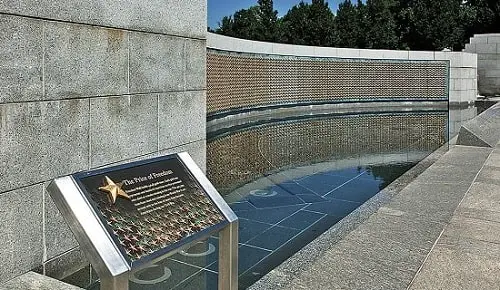
The famous Freedom Wall is located on the plaza’s western edge, with a vista the memorial of Lincoln along with a pool that reflects mesmerizing the visitors.
Freedom wall is adorned with around 4,048 gold stars, and every single gold star signifies 100 Americans killed in the World War.
While the front of the wall is inscribed with a statement that states that the wall marks the price of the freedom.
As one proceeds into the memorial’s traditional entrance from the east, the memorial’s striking symbolic geometry becomes obvious.
The north side of the memorial commemorates the triumph over the Axis powers in Europe, while the south side commemorates the victory in the Pacific.
History
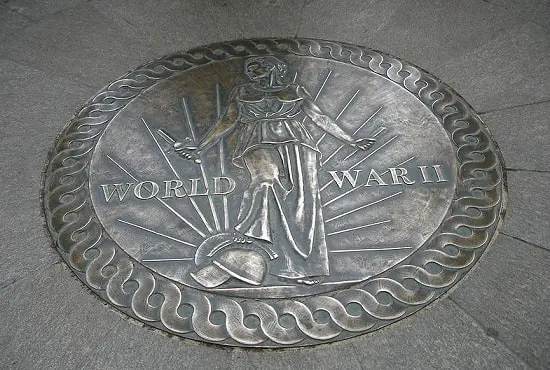
In 1987, a veteran of World War 2- Roger Durbin, addressed Marcy Kaptur, a democrat and representative from Ohio, to inquire about the possibility of erecting the memorial of World War 2.
Then, on December 10, Kaptur proposed HR 3742, the WW2 Memorial Act, in front of the House of Representatives. The proposal was accepted and the commission of the American Battle Monuments were given permission to create the memorial in an area that surrounds Washington D.C.
Still, Congress did not pass on the bill before the session ended. Moreover, Marcy Kaptur also presented similar laws again in 1989 and in 1991, but they followed the same path like the 1st and failed to be made the law.
On the 27th of January, 1993, Kaptur, for the 4th time, presented the bill again to the House of Representatives.
On the 17th of March, 1993, Congress confirmed the act, while the House enacted an altered bill on the 4th of May, 1993.
Congress also adopted the modified bill on the 12th of May, and the U.S President Clinton passed the bill on the 25th of May, 1993.
The Design
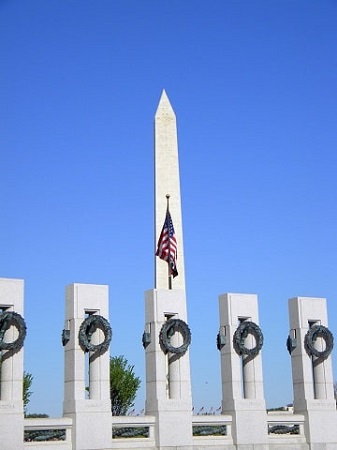
A statewide design contest garnered 400 entries from architects across the country. Subsequently, in 1997, the committee chose designer Friedrich St. Florian’s design as the initial phase design.
The design of St. Florian is reminiscent of a classical landmark. Four eagles hoist an oak laurel wreath beneath 2 of the memorial spires, the Atlantic and Pacific Baldacchino.
All pillars are individually adorned with oak wreaths, representing economic and intelligence power, and wheat, which means crop yields.
St. Florian’s concept was changed within the 4 years as part of the regulatory approval procedure required for planned memorials the D.C.
Similarly, water from the Lincoln Memorial Reflecting Pool rushes into the courtyard via two cascading waterfalls, accumulating underneath the stars, bordering the wall.
Plantings also extend outwards from the memorial’s circumference, smoothing its edge and blending the site into the park surroundings.
Likewise, in the theme of remembering, Oehme van Sweden constrained the plant canvas to white-flowering plants, such as magnolias and azaleas.
FDR’s D-Day Prayer
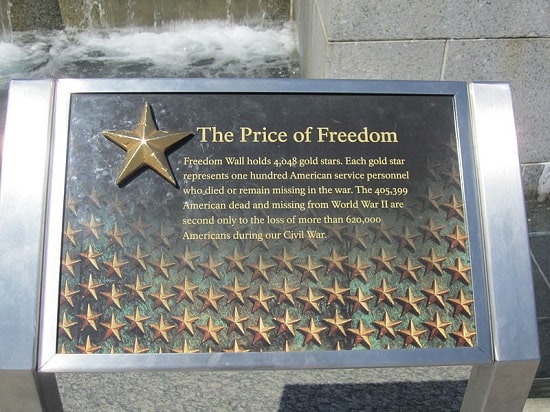
On May 23, 2013, Senator Rob Portman presented the World War 2 Memorial Prayer Act of 2013. The Secretary of the Interior needed to configure an appropriate plaque or inscription at the World War 2 memorial.
President Franklin D. Roosevelt prayed with the phrases alongside the United States on June 6, 1944.
On June 30, 2014, Congress passed the bill, and the Commission of Fine Arts chose a layout at the Circle of Remembrance to the northwest of the WW2 memorial.
Once money and funding are secured, it will be consecrated on June 6, 2022.
Layout and Stylistic Criticism
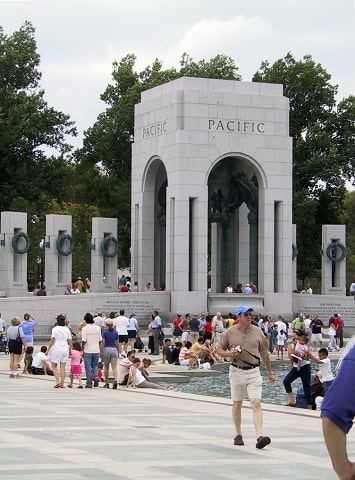
The initial design of the memorial has aesthetic issues. Boston Herald’s critic regarded the memorial as self-aggrandizing, full of hackneyed imagery, and insistent of attention.
On the contrary, an inquirer from the Philadelphia insisted that the pretentious approach was preferred by Benito Mussolini and Adolf Hitler.
As per the Washington Post, the memorial was regarded as overzealous, sensational, and a conglomeration of cliché with the sentimental punch of a block of concrete.
In like manner, president Bill Clinton’s initial idea also contained only 50 pillars recognizing the Union’s 48 states and 2 out of total 8 quasi jurisdictions around the height of world war 2.
The provinces of Hawaii and Alaska were later incorporated as the part of the Union.
Likewise, on the 2nd of June, 1997, the legislative assembly of Puerto Rico passed the Concurrent Resolution. The resolution proposed a pillar commemorating the landmass of Puerto Rico’s involvement in the world war to be included in the design.
The states consisted of Puerto Rico, Alaska, Gwam, Hawaii, the Philippines, American Samoa, Columbia, and Virgin Islands of the U.S.
Some admirers claimed that the structure reminded of New Deal-era federal architecture, motivated by an austere rendition of Art Deco/Beaux-Arts forms.
One architecture critic condemned this viewpoint and the monument as “knee-jerk historicism.”
Location Criticism

For example, the National Coalition to Save Our Mall objected to the memorial’s site.
One major criticism regarding the location was that it would disrupt what had previously been an uninterrupted view between the Washington Monument and the Lincoln Memorial.
The memorial was also chastised for occupying open territory civilians had previously used for large demonstrations and protests.
Consequently, the hastened approval process, which is usually somewhat extensive, particularly irritated critics.
Concerned that World War 2 veterans would perish before an adequate memorial could be completed, the United States Congress passed a resolution absolving the monument from any other site and architectural scrutiny.
In addition, Congress also dropped all ongoing legal objections to the memorial.
Conclusion
Even though the federal government contributed $16 million towards the memorial fund, it needed upwards of $164 million in private funds to complete it.
Moreover, former Kansas Senator Bob Dole, who was seriously injured in the war, and actor Tom Hanks were among its most outspoken advocates.
Moreover, only a tiny percentage of the 16 million Americans who participated in the Great War would see it.
According to government figures, four million World War 2 veterans were surviving at the time, with more than 1,100 deaths every day.
